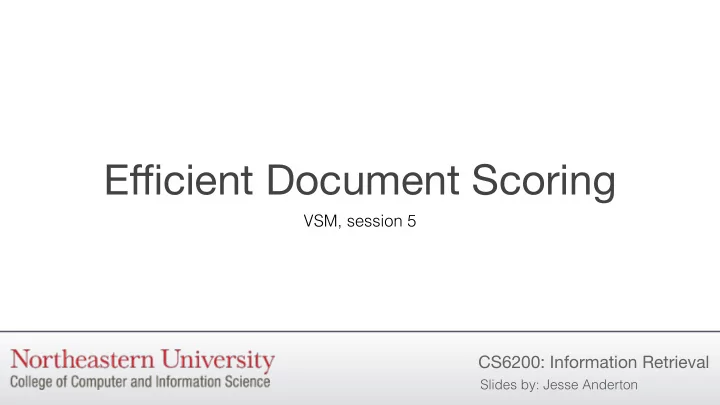

E ffi cient Document Scoring VSM, session 5 CS6200: Information Retrieval Slides by: Jesse Anderton
Scoring Algorithm • This algorithm runs a query in a straightforward way. • It assumes the existence of a few helper functions, and uses a max heap to find the top k items efficiently. • If IDF is used, the values of D and df t should be stored in the index for efficient retrieval.
Faster Scoring • We only care about relative document scores: optimizations that do not change document rankings are safe. • If query terms appear once, and all query terms are equally important, the query vector q has one nonzero entry for each query term and all entries are equal. • Order is preserved if we use a query vector where all values are 1. This is equivalent to summing up document term scores as matching scores.
Faster, Approximate Scoring • If we prefer speed over finding the exact top k documents, we can filter documents out without calculating their cosine scores. ‣ Only consider documents containing high-IDF query terms ‣ Only consider documents containing most (or all) query terms ‣ For each term, pre-calculate the r highest-weight documents. Only consider documents which appear in these lists for at least one query term. ‣ If you have query-independent document quality scores (i.e. user rankings), pre-calculate the r highest-weight documents for each term, but use the sum of the weight and the quality score. Proceed as above. • If the above methods do not produce k documents, you can calculate scores for the documents you skipped. This involves keeping separate posting lists for the two passes through the index.
Cluster Pruning • When building the index, select “leader” √ D documents at random. • All other documents are “followers,” and assigned to the nearest leader (using cosine similarity). query • At query time: ‣ Compare the query to each leader to choose the closest ‣ Compare the query to all followers of the closest leader • Variant: assign followers to the closest b 1 leaders; leader compare query to followers of closest b 2 leaders. follower
Wrapping Up • There are many optimizations we can consider, but they focus on a few key ideas: ‣ For exact scoring, find ways to mathematically deduce the document ranking without calculating the full cosine similarity. ‣ For approximate scoring, choose either query terms or documents which you can safely ignore in order to reduce the necessary calculations without reducing search quality by too much. • Next, we’ll compare the performance of several VSM techniques.
Recommend
More recommend